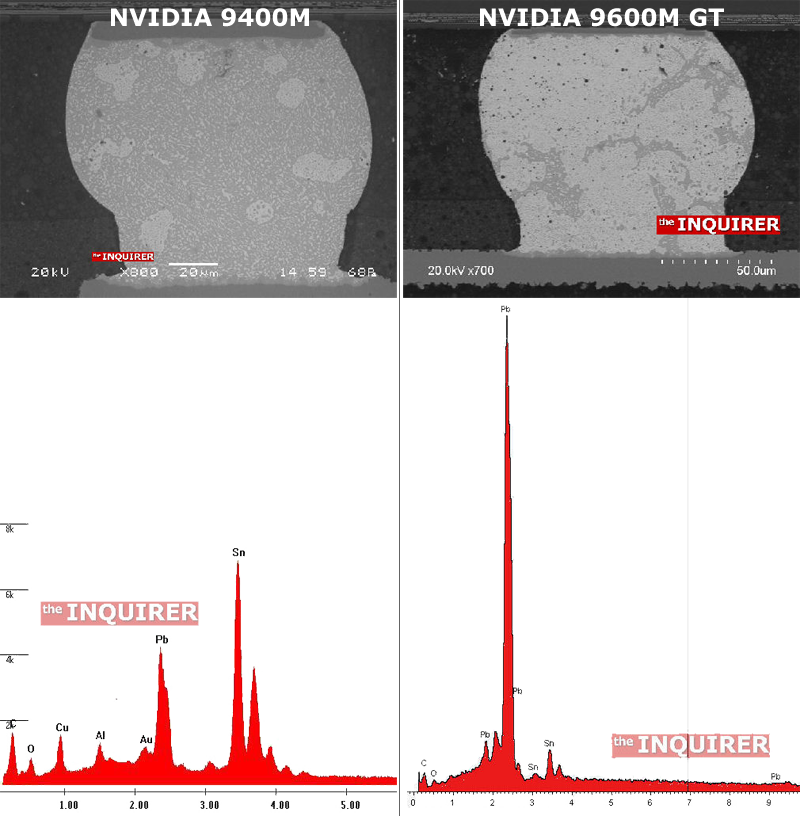Inquirer claims MacBook Pros may use problematic NVIDIA chips
Following its own investigation into the matter, the British technology tabloid concluded that the dedicated NVIDIA 9600M GT graphics chips in the unibody MacBook Pros use the same non-eutectic solder contact bumps as the GeForce 8400M and 8600M family of chips .
Those chips were proven prone to long-term heat damage, which led to notebook recalls from Apple, HP and Dell, and caused NVIDIA to take a $200 million charge back in July as a result. In these cases there were instances where the bumps, or tiny balls of solder, that hold the chip to its circuit board would crack under thermal stress and cause the hardware to become defective.
According to NVIDIA documentation, non-eutectic solder contacts (or "bad bumps") are comprised of mostly lead (95%) and a bit of tin (5%), which can lead to clumping when the material cools. By contrast, eutectic solder contacts (or "good bumps") are made of roughly 63% tin and 37% lead, a composition which cools more uniformly and produces a more consistent grain that's not prone to the same long-term heat damage.
Since the bumps sit permanently sandwiched between the chip die and their green fibreglass package, the only way to determine their composition would be to take a MacBook Pro, disassemble it, desolder the chips, saw them in half, encase them in lucite, and run them through a scanning electron microscope equipped with an X-ray microanalysis system.
The Inquirer claims to have done just this with a MacBook Pro it bought off the shelf in California shortly after the systems were announced in mid-October. It was reportedly aided by a team of unnamed scientists who have access to the multi-million dollar tools required to properly examine the chips.
A profile of the materials found in the bumps used on the MacBook Pro's NVIDIA 9600M GT show a huge spike of lead and only a tiny spike representing tin, leading the Inquirer to conclude that the chip "is unquestionably using bad bumps." The same test run on the MacBook Pro's second, integrated NVIDIA 9400M graphics chip turned up a profile consistent with eutectic solder contacts, and therefore that chip is said to be free of the issues that may plague the 9600M GT.
A profile of the bumps on the MacBook Pro's integrated 9400M (left) compared to that of its discrete 9600M GT counterpart (right).
The Inquirer suggests that the bad bumps used on the 9600M GT are causing a problem on the new MacBook Pros often referred to as the "black screen of death." The issue, which manifests itself when the systems heat up during game play, sometimes causes the notebooks' screens to go black after just a few minutes of gaming, while the systems lock up and the audio enters into an infinite loop. Apple is said to be investigating the problem.
For its part, NVIDIA has vehemently denied the Inquirer's assessment, claiming that the "GeForce 9600 GPU in the MacBook Pro does not have bad bumps. The material set (combination of underfill and bump) that is being used is similar to the material set that has been shipped in 100s of millions of chipsets by the world's largest semiconductor company."
A representative for the chip maker had not responded to AppleInsider's individual request for comment as of press time.
 Katie Marsal
Katie Marsal











 Mike Wuerthele
Mike Wuerthele

 Malcolm Owen
Malcolm Owen
 Chip Loder
Chip Loder

 William Gallagher
William Gallagher
 Christine McKee
Christine McKee
 Michael Stroup
Michael Stroup






